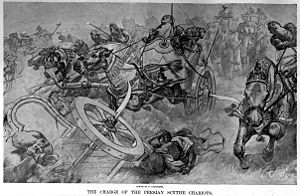m (1 revision) |
m (1 revision) |
Latest revision as of 00:54, 27 February 2010

Ajatasatru's stupa in Rajgir, where his ashes were interred
Ajātashatru (Sanskrit अजातशत्रु; ruled c.491 BC-c.461 BC) was a king of the Magadha empire that ruled north India. He has been referred to as Vedehi-putto-Ajatashatru in Pali texts (being the son of princess of Videha). During his father’s kingship he was a Viceroy at Champa, the capital of Anga, which was annexed to Magadha Kingdom.
Early Life and background
There is not a great deal known about Ajatashatru. What is known is that he became a King of Magadha and the adjoining areas by murdering his father, Seniya/Bimbisara. Also, he was a contemporary of Buddha, was a patron of the then-new religion of Buddhism, and he let the Sangha function in his Kingdom.
Some details of his life are given in the earliest Buddhist scriptures of the Pali Canon. In the Samaññaphala Sutta, Gautama Buddha said that if Ajatasattu hadn't killed his father, he would have attained sotapannahood, a degree of enlightenment. But because he had killed his father he could not attain it. This is also recorded in the Buddhist scripture, the Contemplation Sutra.
Kingdom

The charge of the Persian scythed chariots at the Battle of Gaugamela, by Andre Castaigne (1898-1899).
After the death of his father he enjoyed the revenues of the Kashi which was given to his mother as a dowry in marriage. But his maternal uncle, Prasenjit immediately confiscated the revenues of the Kashi. This resulted into hostilities between two. Next, Ajatashatru, undertook the annexation of the kingdoms of Kosala and Kashi. In return, Ajatashatru married Vajira, the daughter of Prasenjit. Legends say that the one who masterminded Ajatashatru's usurping of the throne was the schismatic monk Devadatta, the reasons being that Ajatashatru was said to have been convinced by Devadatta to help fund his schismatic sangha. Ajatashatru employed two of his ministers, Sunidh and Varshakara, to build a fortress at the village of Patli(called Patligama or Patligrama) as a bulwark to repel attacks of the licchavis and other clan of North Bihar on Magadha, later he shifted his capital to Patligrama which was later known as Patliputra.
He was a great warrior, who conquered 36 republican states surrounding his kingdom and firmly established the predominance of Magadha in Eastern India. The most important war waged by Ajatashatru to gain supremacy over his neighbours was that with the powerful Lichchhavi Republic, ruled democratically by a group of noblemen.They had a powerful leader in Chetaka, in whom Ajatashatru found a formidable adversary. So strong was the Lichchhavi republic that Buddha himself is known to have pronounced it invincible, provided the citizens retained their unity, their liberal and democratic ways and their respect for tradition and elders. He also pursued a sixteen-year war against the Vriji confederacy of Vaishali, what is today north Bihar and Nepal.
The scythed chariot was invented by Ajatashatru, the King of Magadha in Ancient India, in circa 475 BC, who used these chariots against the Licchavis. The scythed chariot was a modified war chariot with a blade(s) mounted on both ends of the axle.
Later life
Years of restless yearning, war and violence tormented Ajatashatru's soul and his profound sorrow ultimately brought him to the feet of Lord Buddha, where he found peace. So completely was Ajatashatru converted to the faith that he was chosen as the chief claimant of Buddha's relics after the latter's death. Ajatashatru subsequently built stupas all over the capital and renovated 18 monasteries in memory of Buddha. Later, he convened the first Buddhist General Council.
Legacy
According to some historians, Ajatashatru was responsible for building Pataliputra[1] and strengthening the defences of the Magadhan capital, Rajagriha.
Assassination
Ajatashatru also suffered the same miserable fate as his father, being put to death by his son Udayi-Bhadda/UdayiBhadra in 459 B.C.
Depictions in popular culture
- A fictionalized account of Ajatashatru - depicted as a physically gross and tyrannous figure - appears in Gore Vidal's novel Creation.
- A movie about his life was released titled Ajatashatru. He also features as the protagonist in the movie Amrapali.
- A book about his life was written titled Ajatashatru, by Subba Rao.[2]
See also
- Samaññaphala Sutta
- Ambapali or Amrapali
References
Further reading
- Romila Thapar, 1996. A History of India (Volume One). Oxford University Press.
- G.P.Singh,2004. "Early Indian Historical Tradition and Archaelogy". D.K.Printworld(P)Ltd-New Delhi-110015; page164,165
External links
| Regnal titles | ||
|---|---|---|
| Preceded by Bimbisara |
Emperor of Magadha 493 BCE – 461 BCE |
Succeeded by Darshaka |
cs:Adžátašatru ko:아자타샤트루 hi:अजातशत्रु (मगध का राजा) ja:アジャータシャトル pt:Ajatashatru ta:அஜாத சத்ரு th:พระเจ้าอชาตศัตรู vi:A-xà-thế